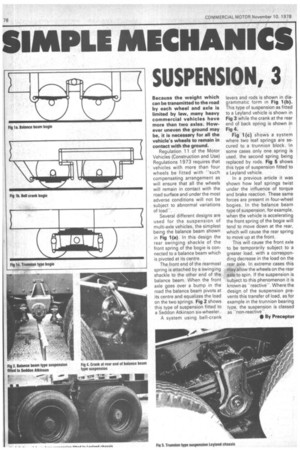SIMPLE MECHANICS
Page 82

If you've noticed an error in this article please click here to report it so we can fix it.
SUSPENSION, 3
Because the weight which can be transmitted to the road by each wheel and axle is limited by law, many heavy commercial vehicles have more than two axles. However uneven the ground may be, it is necessary for all the vehicle's wheels to remain in contact with the ground.
Regulation 11 of the Motor Vehicles (Construction and Use) Regulations 1 973 requires that vehicles with more than four wheels be fitted with "such compensating arrangement as will ensure that all the wheels will remain in contact with the road surface and under the most adverse conditions will not be subject to abnormal variations of load".
Several different designs are used for the suspension of multi-axle vehicles, the simplest being the balance beam shown in Fig 1(a). In this design the rear swinging shackle of the front spring of the bogie is connected to a balance beam which is pivoted at its centre.
The front end of the rearmost spring is attached by a swinging shackle to the other end of the balance beam. When the front axle goes over a bump in the road the balance beam pivots at its centre and equalizes the load on the two springs. Fig 2 shows this type of suspension fitted to a Seddon Atkinson six-wheeler.
A system using bell-crank
levers and rods is shown in diagrammatic torm in Fig 1 (b). This type of suspension as fitted to a Leyland vehicle is shown in Fig 3 while the crank at the rear end of back spring is shown in Fig 4.
Fig 1(c) shows a system where two leaf springs are secured to a trunnion block. In some cases only one spring is used, the second spring being replaced by rods. Fig 5 shows this type of suspension fitted to a Leyland vehicle.
In a previous article it was shown how leaf springs twist under the influence of torque and brake reaction. These same forces are present in four-wheel bogies. In the balance beam type of suspension, for example, when the vehicle is accelerating the front spring of the bogie will tend to move down at the rear, which will cause the rear spring to move up at the front.
This will cause the front axle to be temporarily subject to a greater load, with a corresponding decrease in the load on the rear axle. In extreme cases this may allow the wheels on the rear axle to spin. If the suspension is subject to this phenomenon it is known as "'reactive". Where the design of the suspension prevents this transfer of load, as for example in the trunnion bearing type, the suspension is classed as "non-reactive".
• By Preceptor






















































































































































